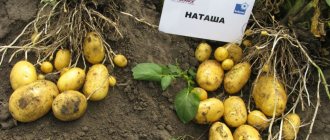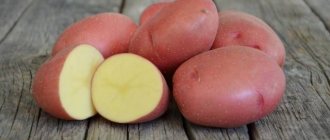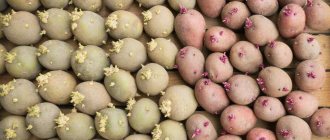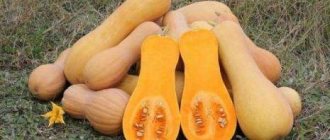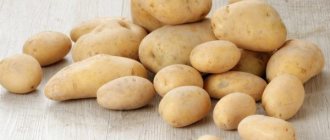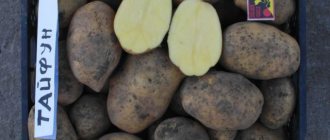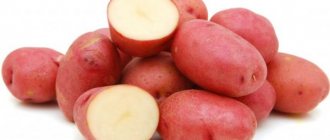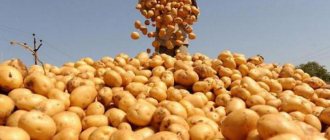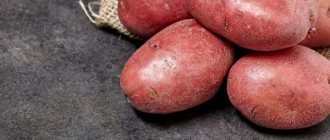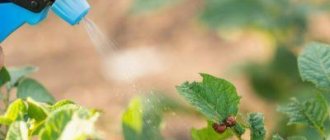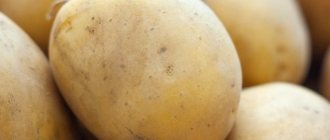Planting potatoes and caring for them is a labor-intensive and sometimes thankless task. After all, not every variety has good yield. Unlike Picasso potatoes. This variety guarantees large volumes of mature root crops, subject to the rules of watering, fertilizing and hilling, as well as careful selection of planting material.
Characteristics of Picasso potatoes
This potato variety was bred in Holland. It was entered into the Russian register in 1995. Picasso potato tubers, according to the description of the variety and in the photo, have an attractive presentation. In Russia, this variety is also known under other names, for example, Ivan da Marya.
The plant is considered late. Directly from planting to harvest, 130 days pass. Productivity per hundred square meters is 200-300 kg. One bush produces approximately 20 potatoes. The shrub itself has spreading tops.
The fruits are oval-round in shape and contain few eyes. Tuber weighing up to 100 g. Potatoes got their name because of their color - the tubers are yellow-pink in color. It was in these shades that the famous artist worked at the very beginning of his creative career. At the same time, the starch content is not higher than 12%. Potatoes do not spoil during transportation. Has high safety parameters. If the storage rules are followed, it will not even germinate during the winter.
The Picasso variety tolerates drought and high temperatures well. Preferred regions for cultivation are Central and Central Black Earth.
Advantages
The main advantages of Picasso potatoes include:
- high yield of the variety;
- possibility of long-term storage - almost until the next season;
- good taste of Picasso potatoes;
- the resistance of this vegetable crop to nematodes, potato cancer and some viruses;
- good presentation of tubers;
- high resistance to hot seasons and periods of drought.
But this potato also has some disadvantages that you should be aware of:
- low resistance to late blight;
- The starch content in the tubers is low, so not everyone likes the taste of this potato (but this is a subjective remark);
- bushes of this variety suffer greatly from attacks by the Colorado potato beetle;
- Picasso potatoes require high soil fertility.
Planting and caring for Picasso potatoes
The characteristics of the Picasso potato variety are suitable for many gardeners and for farmers growing potatoes for sale. But to obtain the maximum yield from one bush, all agrotechnical requirements must be observed. The variety is not considered capricious, but there are still some nuances regarding planting and care.
Selection and preparation of a landing site
When choosing a site, you should pay attention to the lighting. The optimal place is a sunny area, preferably in a lowland. The soil in the selected area should warm up to at least + 7 °C. This is the only guarantee that the tubers will not freeze in the ground.
It is advisable to prepare the soil in the fall. To do this, you need to add humus, rotted manure, ash and superphosphate.
To avoid a decrease in yield and the appearance of late blight, crop rotation should be observed. Transplanting potatoes from place to place in small areas is quite difficult. But there are some crops that are considered optimal potato predecessors:
- garlic and onion;
- cabbage;
- cucumbers;
- all legumes.
In this case, you don’t have to worry about the health and yield of potatoes. But it is not recommended to plant potatoes after tomatoes. These are relatives, which means that all pest diseases after tomatoes can damage the potato crop.
Preparation of planting material
2 weeks before planting, the seed material must be scattered in a warm room in 1 layer. Tubers should be selected small in size, approximately the size of a chicken egg. As soon as the tubers turn green and begin to sprout, the seed material is ready for planting.
Landing rules
There is a true folk sign according to which potatoes are planted in most regions - birch leaves have begun to bloom. For the Picasso variety, the optimal planting pattern is 45x70 cm. At this distance, thick and tall potato bushes will not block each other’s light.
To plant this variety, the site is dug up twice. For planting, it is better to germinate the tubers. In this case, they will give higher yields. For germination, tubers are placed in conditions with temperatures above + 10 ° C. Can be treated with special stimulating drugs to accelerate the appearance of sprouts. It is good to keep the sprouted tubers in a solution of boric acid and copper sulfate 2-3 weeks before planting. This will significantly strengthen the potato’s immunity.
If you cut the tubers to obtain a harvest in order to save money, the plant will have weak immunity, so experts advise using the entire tubers as planting material.
The depth of the hole or trench for planting is 10-15 cm.
Watering and fertilizing
The variety is demanding on feeding. It is difficult to achieve high yields without applying fertilizers.
You need to apply organic, mineral and nitrogen fertilizers during the season. Typically, fertilizing is carried out after the first shoots appear, then at the first buds, and also during flowering. It is undesirable to fertilize potatoes after they have flowered; this can negatively affect the harvest.
In the first period of the growing season, cow and bird droppings are most often used, and in the second - potash and phosphorus fertilizers.
Picasso should be watered once a week using the drip method at the rate of 4-5 liters of water for each bush. After flowering, the number of waterings should be reduced to once every 2 weeks. If the summer passes with sufficient rainfall, then watering may not be necessary.
Loosening and weeding
Experts recommend loosening the next day after watering. This procedure helps deliver oxygen to the tubers and make the soil lighter.
Weeding is an important agrotechnical activity. Weeds not only interfere with potato growth by blocking light, but can also be carriers of diseases. Weeding is best done together with loosening the soil. You should also be sure to remove weeds as they appear and not allow the beds to become overgrown. This way, the yield will be significantly higher, and the potato bushes will not have to be additionally treated for diseases.
Attention! Lush tops can interfere with weeding and pest control. This is a small minus of the Picasso variety.
Hilling
Hilling is another important event in agricultural technology. It is necessary to carry out the first hilling when the potato bushes are only 7 cm in length.
Then repeat the procedure two more times until the potatoes finish budding. Hilling is carried out on loamy and clayey soils. On sandy soils there is no point in the procedure. It is also not recommended to hill up potatoes if the soil temperature reaches 26 °C and the air temperature remains high. If at the same time there is still not enough moisture in the soil, then the procedure can harm the plant.
If you don’t want to hill up potatoes, you can initially plant them under black covering material.
Hilling helps increase productivity by 30%. In addition, the procedure helps:
- improve plant lighting;
- protect the plant from drying out;
- protect tubers from sudden temperature changes;
- increases the resistance of potatoes to winds and spring frosts;
- prevent the appearance of new weeds after weeding.
Hilling can be done with a hoe, shovel or hand hiller.
Features of cultivation
The Picasso variety needs periodic feeding. It is usually carried out in three stages:
- during the first hilling;
- at the beginning of potato flowering;
- at the moment of mass flowering.
For the first feeding, use a solution of chicken manure (take 1 part of the substance per 15 liters of water), and for the rest - phosphorus or potassium fertilizers.
Important! Any feeding of potatoes stops a month before harvesting.
Weeding and loosening begin when the seedlings reach a height of 6-8 cm. And the first hilling is only after they grow to 10 cm. This process is repeated every 2 weeks.
Picasso potatoes do not need frequent watering. It needs additional moisture during the flowering period or during a long absence of precipitation. In total, 2-4 waterings are carried out during the summer season.
Diseases and pests
The Picasso potato variety tolerates most diseases well and has strong immunity. Resistance has been recorded to the following diseases:
- nematode;
- leaf curling;
- cancer;
- fungal diseases;
- Fusarium
The only pathology from which crops should be protected is late blight. The main symptom is a white limescale coating on the outside of the leaves. If the crop is not treated in time, the tubers will also be affected, on which dark brown spots will appear and spread to neighboring bushes. This could destroy the entire crop. Preventive measures to combat this disease:
- bushes should not grow too densely so that they are properly ventilated;
- Hill up the potatoes at least 2 times before budding;
- treat the tubers with special preparations against late blight;
- observe crop rotation and do not plant potatoes after other nightshade crops.
To prevent the disease, spraying potato bushes with garlic solution or sour milk also helps.
When the first symptoms of late blight appear on the leaves, it is necessary to treat the bushes with chemicals as soon as possible.
It is very important that the most common potato pest, the Colorado potato beetle, does not like Picasso. This is also indicated in the description of the variety. But for prevention, it doesn’t hurt to plant garlic around the potatoes.
Description of the variety
The variety was created by the Netherlands at the end of the 20th century. In 1995 it was adopted by the State Register. The Picasso variety is recommended for cultivation in the Central and Central Black Earth regions; it is widely distributed in the southern regions of Russia, Ukraine, and Belarus.
Picasso forms a fairly tall, erect bush with white flowers and large leaves.
Characteristics of tubers
Potatoes of the Picasso variety produce medium-sized tubers with a beautiful round-oval shape. The peel is thin, yellow, with pink spots around the eyes. The flesh is creamy. The eyes are small and few in number – a sign of table potato varieties. The weight of a commercial tuber ranges from 75-125 grams.
The starch content of Picasso tubers is slightly lower than the standard - 7.9-13.5%. Taste qualities are rated as satisfactory and good. The taste greatly depends on the composition and fertility of the soil. The best tubers can be obtained on fertile sandy loams.
Potatoes of this variety are slightly boiled and are intended for preparing salads, first courses, and frying.
Productivity
Picasso is a late table variety; 110-130 days pass from the emergence of seedlings to harvesting. The variety is intended for winter storage; young tubers are rarely put on the market.
Picasso potato yield
| Yield indicators | c/ha | |
| Average yield | in the Central Black Earth region | 190 |
| in Central it is much higher | 193-315 | |
| Maximum recorded yield | 321 | |
Comment! With good care, you can harvest an average of 17 potatoes from one bush (maximum 20).
Resistance to pests and diseases
The Picasso variety is highly resistant to a number of diseases and pests:
Susceptibility to scab and leaf curl is average. The Picasso variety is often affected by late blight.
To prevent the development of diseases, crop rotation and agricultural practices should be observed, and preventive treatments with fungicides or phytosporin should be carried out.
You will have to fight the Colorado potato beetle on potatoes using insecticides, folk remedies, which may not be so harmless, or manually.
Picasso potato yield
According to characteristics and reviews, the Picasso potato variety has good yield. Suitable not only for growing in the country or in the garden, but also for industrial production. From 1 hectare, under the right conditions, agricultural techniques harvest up to 500 centners. Compared to most known varieties, this is a high yield parameter. One bush produces up to 20 fairly large tubers. From one hundred square meters he gets 250 kg.
It is better to dig up potatoes in dry and sunny weather. Harvest time is mid-September. In order for the root crops to become stronger in mid-August, when the tops turn yellow, it is advisable to cut them off.
Storage
A distinctive feature of the Picasso variety is its high keeping quality. Germination parameters until spring, subject to storage conditions, are practically zero. For storage, it is necessary to dry the tubers in the fresh air immediately after digging. Be sure to clear them of soil and sort them thoroughly. Any tuber showing signs of disease or rot should be discarded to prevent it from ruining the entire harvest.
For those who do not grow potatoes themselves, it is also better to purchase Picasso for winter storage.
Optimum storage temperature + 4 °C. It is better to use bags or nets for storage. If you store potatoes in bulk in the cellar, the thickness should be no more than 1 m so that the tubers do not overripe and excessive moisture is not created. In the room intended for storage, there should be no condensation or humidity on the walls. This is an important condition for the safety of not only potatoes, but also all products for the winter.
Reviews of Picasso potatoes
Sviridov Gennady Yurievich, 45 years old, Novgorod region
I have several varieties of potatoes growing in my garden. I have been planting Picasso for several years now as a late plant for winter storage. The variety is practically disease-free; it is important to treat it against late blight. I treat it with garlic solution. If you plant garlic around potatoes, you will also forget about the Colorado potato. At the same time, large, oval tubers are perfectly stored until spring and do not germinate. I recommend to everyone.
Shparin Viktor Sergeevich, 38 years old, Rostov
I am an experienced farmer, growing and selling vegetables. I really like the Picasso potato variety. Withstands long-term transportation well. There is practically no need to reject products, no matter where in Russia I take them. The yield is also attractive - 400 centners per hectare. In terms of agricultural technology, the variety is not capricious, which is important for industrial cultivation.
